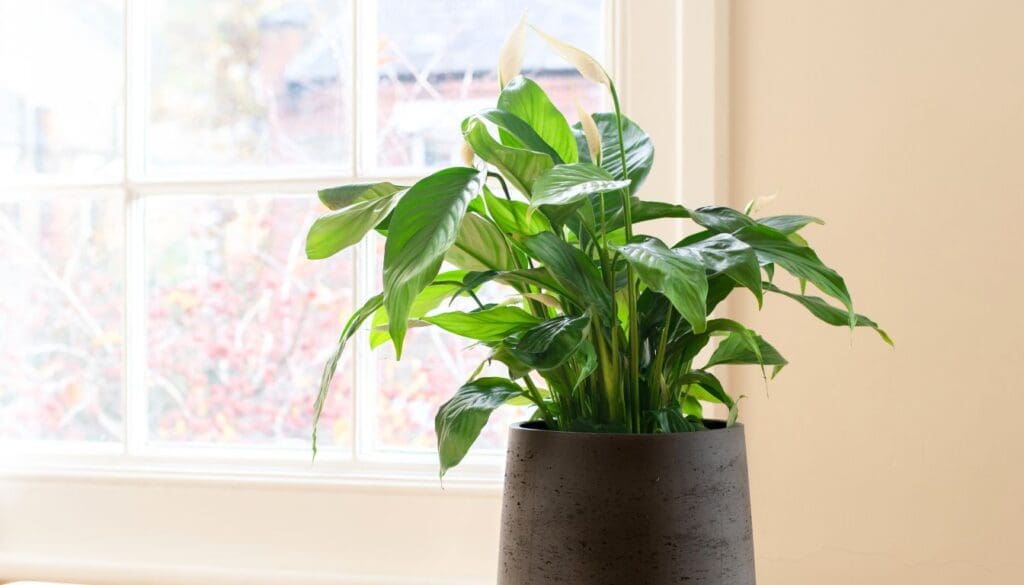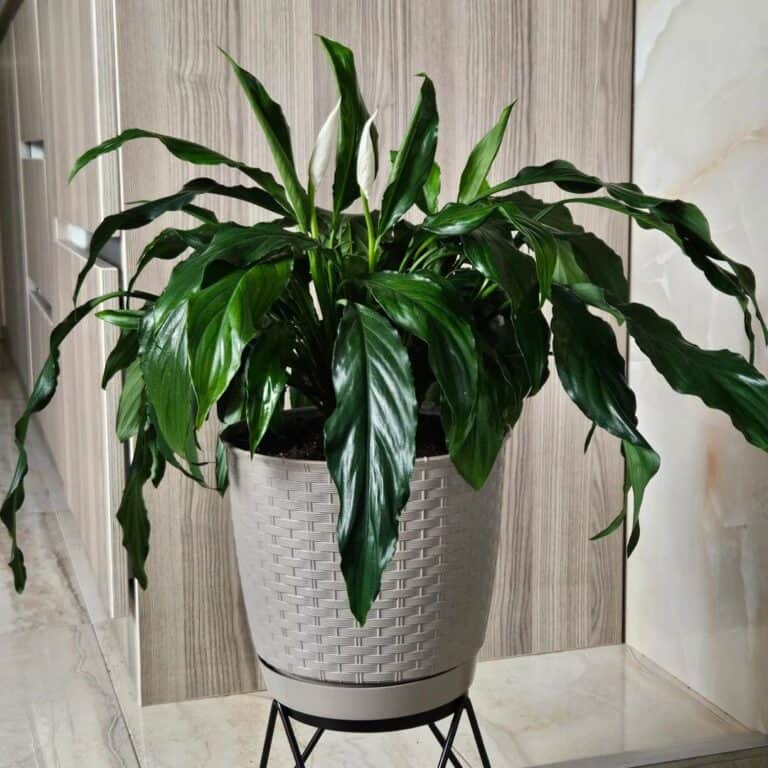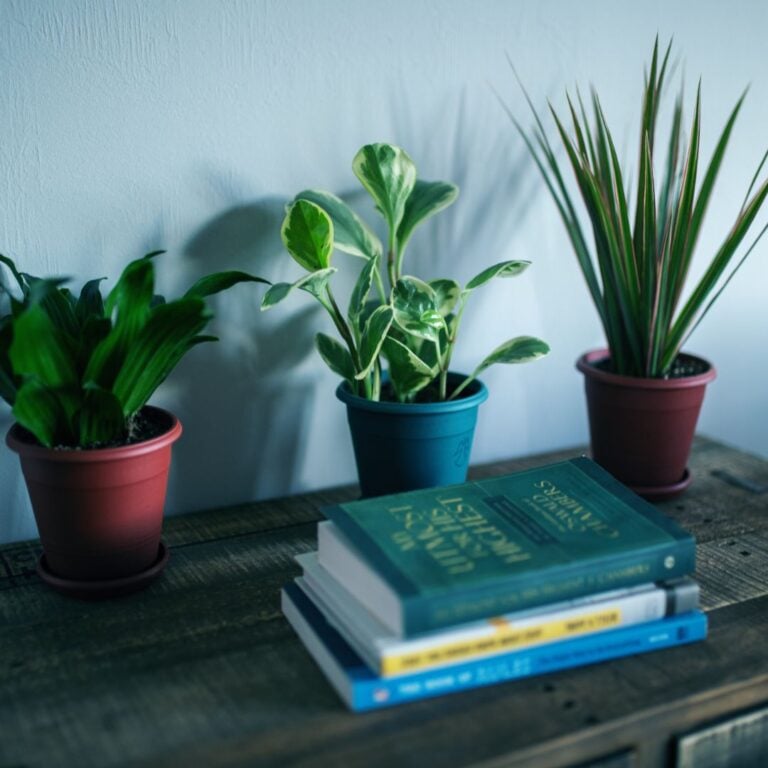6 Low‑Light Plants That Love Winter Windowsills
I really enjoy having plants around, even when winter rolls in and the days get shorter. Some just seem to thrive in those dim corners and still liven up a windowsill.
You can still have greenery indoors even if the sunlight isn’t exactly pouring in.
I’ve noticed that a few plants actually do just fine in low light and cooler months. That makes them perfect for winter care.
Let me share a few hardy options I’ve tried, plus some easy tips to keep them happy as the season shifts.
Please note: Simplify Plants is reader-supported. As an Amazon Associate, I earn from qualifying purchases made by our readers with no extra cost added to you all! Some links in the post are affiliate links and I get a commission from purchases made through links in the post.
1) Snake Plant

I keep a Snake Plant on my windowsill all winter. It doesn’t mind low light at all, so I can just let it be, even if the sun disappears for a while.
Its tall, upright leaves with green and yellow edges look tidy and fit nicely in tight spots.
Honestly, it barely needs any attention. I only water it when the soil is dry, which can be every few weeks when it’s cold.
The Snake Plant also seems totally fine with dry indoor air, making it a solid pick for rooms with the heat running.
It grows slowly, so there’s no rush to repot. Less fuss, more enjoyment.
I have to admit, the best thing is how tough it is. If I forget about it for a bit, it just keeps looking healthy and strong.
2) ZZ Plant

The ZZ Plant really livens up my windowsill in winter. Its shiny, dark green leaves stay glossy with barely any care.
I never worry about it drooping when the days are short. It’s just not that fussy.
This plant actually prefers low light, so cloudy winter days don’t bother it. I keep mine near a window, but it doesn’t crave direct sun.
It’s also super low maintenance. I only water it when the soil dries out, and honestly, it’s better to underwater than overwater.
My apartment gets dry in winter, but the ZZ Plant still looks unfazed. No need for fancy humidity tricks or special attention.
It grows slowly and stays compact, which is perfect for a small windowsill.
The best part? It’s so forgiving. If I forget to water it for a week or two, it doesn’t skip a beat.
3) Pothos

I like having a Pothos on my windowsill since it handles low light like a champ. Plus, it doesn’t demand much attention, which is great for days when I’m all over the place.
The leaves keep their shine through winter and seem to brighten the whole space. Pothos can handle indirect light, so I don’t stress over the short daylight hours.
I water it only when the soil feels dry. Overwatering is a no-go for the roots, so I keep things simple.
One thing I enjoy is training the vines. They can trail down or wrap along a shelf, and it always looks cool.
Pothos is also easy to propagate. I just snip a stem with a few leaves and stick it in water—new roots show up before you know it.
It gives me that green touch all winter, and honestly, it might be the easiest plant I’ve ever owned.
4) Cast Iron Plant

The Cast Iron Plant is a favorite of mine because it’s practically made for low light. Even when winter days are gloomy, its deep green leaves don’t fade.
I don’t bother with direct sun. A north-facing windowsill or a shady corner is just fine.
It grows slowly but stays steady, so you don’t have to keep moving it around.
I water it only when the top soil is dry. Too much water is a risk, so I play it safe.
The long, glossy leaves look neat without much effort. I just give them a quick wipe now and then to keep the dust off.
Fertilizer? Hardly ever. Maybe once or twice in the warmer months, and that’s it.
It doesn’t mind cooler rooms, so even drafty windows in winter aren’t a problem. It keeps looking healthy without much fuss.
Honestly, it’s a reliable pick for anyone who wants a plant that just stays green without needing constant attention.
5) Spider Plant

The Spider Plant is a classic for winter windowsills. It’s so easy to care for, and it actually grows well in low light.
Those long green leaves with white stripes really do brighten up a dull spot. Even if the sun’s barely out, the plant still looks fresh.
I water it only when the soil feels dry on top. It’s not needy at all, which I appreciate.
One of the fun parts is the baby plantlets it sends out on long stems. I snip them off and root them in little pots—easy way to get more plants.
The Spider Plant also takes cooler indoor air in stride. It’s a dependable choice for my winter windowsill.
6) Peace Lily

I keep a Peace Lily on my windowsill because it’s easy to care for and always looks fresh. The dark green leaves stay bright, even when daylight is scarce.
It’s totally fine in low light, which is a relief in winter. Too much sun can actually be a problem for its leaves, so indirect light is best.
I aim to keep the soil just slightly moist—never soggy. If the leaves start to droop, I know it’s time for water.
Those white blooms add a clean look, even when most plants aren’t flowering. Wiping the leaves keeps them shiny and helps the blooms last longer.
I also like that the Peace Lily helps keep the air feeling a bit fresher. Maybe it’s not a huge difference, but it’s still a nice bonus.
It’s a great pick for a winter windowsill—healthy, calm, and not much effort required.
Caring for Low-Light Plants in Winter
When winter hits, I pay attention to three main things: how I water, the air around my plants, and how much sunlight they’re getting. Tweaking these just a bit can really help.
Adjusting Watering Routines
I water less often in winter since most plants aren’t growing much in the cold. If I stick to my summer routine, the soil stays wet too long and roots might rot.
I poke a finger into the top inch of soil before watering. If it’s still damp, I wait.
I use room-temperature water so I don’t shock the roots. For small pots, I pour slowly and stop when water shows up in the saucer.
Larger pots get a slow, even soak to reach all the roots.
Here’s a quick guide I go by:
| Plant Size | Watering Frequency | Check Soil Depth |
|---|---|---|
| Small pot | Every 10–14 days | 1 inch |
| Medium pot | Every 2–3 weeks | 1–2 inches |
| Large pot | Every 3–4 weeks | 2 inches |
This way, the soil stays moist but never soggy.
Managing Indoor Humidity
Heaters dry out the air, and I notice brown leaf tips when humidity drops. To help, I group plants together so they make a little pocket of moisture.
I also put a tray of water with pebbles under some pots. As the water evaporates, it bumps up the humidity around the plants—roots stay dry, but leaves stay happy.
A small humidifier works well too, especially in bedrooms or offices.
I don’t mist leaves much in winter since it can cause fungal spots. Instead, I focus on keeping the general humidity steady.
Keeping plants away from heater vents helps them avoid drying out too quickly.
Maximizing Limited Sunlight
Winter light can be pretty weak, so I move my plants as close as possible to south- or east-facing windows. I wipe the glass now and then since even a bit of dust blocks light.
If a plant still looks pale or leggy, I’ll use a small grow light for a few hours in the evening. I keep the light about 6–12 inches above the leaves—close, but not too intense.
Rotating the pots every week helps too. It keeps the plant from leaning and helps all sides grow evenly.
Little steps like these give my plants a better shot at thriving, even with less winter sun.
Common Challenges and Solutions
Low-light plants can run into a few issues in winter. The biggest problems I see are yellowing leaves and stress from cold air.
Preventing Leaf Yellowing
If I spot yellow leaves, I check the soil first. Overwatering is usually the culprit, so I let the top inch dry out before watering again.
Good drainage is key. I always use pots with holes in the bottom and a saucer underneath to keep roots from sitting in water.
If yellowing sticks around, I look at the light. Even low-light plants need some brightness, so I move them closer to a window for more indirect light.
Sometimes it’s just old leaves falling off, which is normal. I trim those so the plant can focus on new growth.
Quick checklist:
- Let soil dry out a bit before watering
- Use pots with drainage holes
- Move plants near bright, indirect light
- Remove old or damaged leaves
Dealing With Cold Drafts
Cold air from windows or doors can really bother plants. I check for drafts by standing near the window on a chilly day—if I feel it, so does the plant.
I move them a few inches away from the glass. Even a little space helps.
A thick curtain or weather strip on the window blocks cold air pretty well.
Plants don’t like sudden temperature swings either, so I keep them away from heaters, vents, and doors that open a lot.
If a room’s especially cool, I group plants together. They seem to create a slightly warmer, more humid spot that way.
Tips I follow:
- Move plants a few inches from cold windows
- Block drafts with curtains or strips
- Avoid heaters and vents nearby
- Group plants for extra warmth and humidity
Frequently Asked Questions
People often ask me which plants stay healthy during darker months, how to water them right, and how to tell if they need more light.
I’ve picked up some simple tricks to keep them going strong, even when the days are short.
What are some hardy plants that thrive in low-light conditions during winter?
I’ve honestly had great success with Snake Plant, ZZ Plant, and Pothos.
Cast Iron Plant and Spider Plant have also hung in there, even when sunlight’s basically a rumor.
How do I care for indoor plants when there’s less natural light available?
I try to scoot my plants closer to the windows and make sure the curtains are open whenever I remember.
Rotating them helps too—each side gets a bit of whatever light we can find.
Can you recommend any plants that grow well on windowsills with limited winter sunlight?
Pothos and Spider Plant don’t seem to mind weaker light on the windowsill.
Snake Plant is surprisingly chill about low sun, too.
What are the best practices for watering indoor plants in low-light, colder months?
I cut back on watering since the soil just doesn’t dry out as fast in winter.
Usually, I poke my finger into the top inch of soil and only water if it feels dry—no guessing games.
How can I tell if my plant is getting enough light during the winter season?
I watch for pale leaves, slow growth, or leaves dropping—classic warning signs.
If it looks sad, I’ll move the plant closer to a window and hope for the best.
Are there any tips for improving the growth of houseplants in darker winter environments?
I usually turn to grow lights when there just isn’t enough sunlight—winter can be pretty tough on plants, right?
Dusting off the leaves helps them soak up whatever light they can get, and honestly, it makes them look nicer too.
Oh, and I always try to keep my plants away from chilly drafts; they really don’t like the cold.
Recommended Garden Supplies
| Product Image | Our Recommended Gardening Supplies | Check Offers! |
|---|---|---|
Top Top
Top
Top
Top
Top
Top
Top
Top | rePotme Houseplant and Tropical Classic Potting Soil Mix | Check Offer On Amazon |
 Top
Top
Top
Top
Top
Top
Top
Top | Espoma Organic Indoor Plant Food | Check Offer On Amazon |
 Top
Top
Top
Top
Top
Top
Top
Top | GooingTop LED Grow Light 6000K Full Spectrum Clip Plant Growing Lamp | Check Offer On Amazon |
 Top
Top
Top
Top
Top
Top
Top
Top | Soil Moisture Meter | Check Offer On Amazon |
 Top
Top
Top
Top
Top
Top
Top
Top | Govee Hygrometer Thermometer, Bluetooth Enabled! | Check Offer On Amazon |
 Top
Top | LEVOIT Humidifiers for Large Room(Best For Plants) | Check Offer On Amazon |
 Top
Top
Top
Top
Top
Top
Top
Top | Upgraded DIY Automatic Drip Irrigation Kit, 15 Potted Houseplants Support | Check Offer On Amazon |
 Top
Top
Top
Top
Top
Top
Top
Top | Stainless Steel Heavy Duty Gardening Tool Set | Check Offer On Amazon |
 Top
Top
Top
Top
Top
Top
Top
Top | Bonide Insecticidal Soap | Check Offer On Amazon |
 Top
Top
Top
Top
Top
Top
Top
Top | Bonide 32 oz Spray Neem Oil for Organic Gardening | Check Offer On Amazon |
 Top
Top
Top
Top
Top
Top
Top
Top | Garden Safe Fungicide | Check Offer On Amazon |






